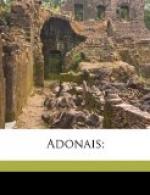+Stanza 19,+ 1. 2. A quickening life, &c. The present stanza is generally descriptive of the effects of Springtime upon the earth. This reawakening of Nature (Shelley says) has always taken place, in annual recurrence, since ’the great morning of the world when first God dawned on chaos.’ This last expression must be construed with a certain latitude. The change from an imagined chaos into a divinely-ordered cosmos is not necessarily coincident with the interchange of seasons, and especially the transition from Winter to Spring, upon the planet Earth. All that can be safely propounded on such a subject is that the sequence of seasons is a constant and infallible phenomenon of Nature in that condition of our planet with which alone we have, or can have, any acquaintance.
1. 5. In its steam immersed: i.e. in the steam—or vapour or exhalation—of the ‘quickening life.’
+Stanza 20,+ 11. 1, 2. The leprous corpse, touched by this spirit tender, Exhales itself in flowers of gentle breath. ’This spirit tender’ is the ‘quickening life’ of the renascent year; or briefly the Spring. By ‘the leprous corpse’ Shelley may mean, not the corpse of an actual leper, but any corpse in a loathsome state of decay. Even so abhorrent an object avails to fertilize the soil, and thus promotes the growth of odorous flowers.
1. 3. Like incarnations of the stars, &c. These flowers—star-like blossoms—illumine death and the grave: the light which would belong to them as stars is converted into the fragrance proper to them as flowers. This image is rather confused, and I think rather stilted: moreover, ‘incarnation’ (or embodiment in flesh) is hardly the right word for the vegetative nature of flowers. As forms of life, the flowers mock or deride the grave-worm which battens or makes merry on corruption. The appropriateness of the term ‘merry worm’ seems very disputable.
1. 6. Nought we know dies. This affirmation springs directly out of the consideration just presented to us—that even the leprous corpse does not, through various stages of decay, pass into absolute nothingness: on the contrary, its constituents take new forms, and subserve a re-growth of life, as in the flowers which bedeck the grave. From this single and impressive instance the poet passes to the general and unfailing law—No material object of which we have cognizance really dies: all such objects are in a perpetual cycle of change. This conception has been finely developed in a brace of early poems of Lord Tennyson, All Things will Die, and Nothing will Die:—
’The stream will cease to flow,
The wind will cease to blow,
The clouds will cease to fleet,
The heart will cease to beat—
For all things must die.
* * * * *
’The stream flows,
The wind blows,
The cloud fleets,
The heart beats,
Nothing will die.
Nothing will die;
All things will change
Through eternity.’




